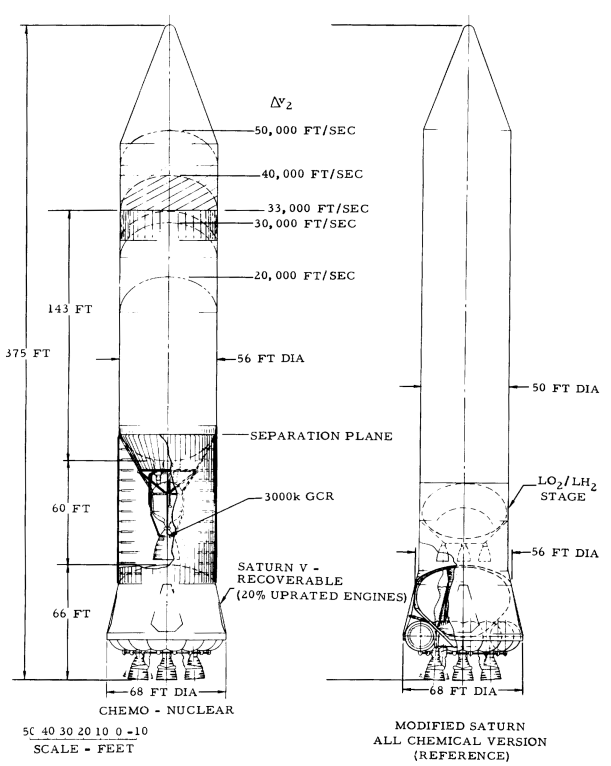In 1963, Convair floated the idea of a Saturn V first stage modified to be in like with their “Nexus” thinking. It was to be a fully recoverable, very squat stage, with little apart from the F-1 engines in common with the standard S-IC stage… and even the F-1’s were uprated.
The cylindrical propellant tanks were done away with; the LOX tank was formed by a roughly conical, round-ended tank on the centerline, while the kerosene tank was repaced by a series of intersecting spherical tanks forming a torus wrapped around the LOX tank. Flaps were added to the conical sides of the stage to control re-entry and descent. The F-1 engines were to be uprated by 20%.
l
(At least)) Two upper stages were envisioned… a modified S-II stage of increased diameter (50 rather than 33 feet) and reduced length, and a 56-foot-diameter nuclear stage equipped with a single 3,000,000 pound-thrust gas-core nuclear thermal rocket engine. Baseline mission for the nuclear version was to lob 920,000 pounds of payload onto a 40,000 ft/sec parabolic (Earth escape) orbit. Different mission velocities could be achieved by lengthening or shortening the nuclear stage hydrogen tank.
————-
Do you like posts like this? Then show yor appreciation! Buy My Stuff, such as aerospace drawings and documents and Aerospace Projects Review. Or you could just Donate. For more posts like this, click on the Unwanted Blog header up top and then click on the “Projects” category to the right (or just click the “Projects” link to the right, if you happen to see it).
3 Responses to “REALLY Modified Saturn V”
Sorry, the comment form is closed at this time.


Woooh
how many study of NEXUS are there ?!
and yes i like those posts
wanted to buy them in form of PDF or eAPR form
Well the nice thing about the Nexus-style stages is they can be adapted to all sorts of upper stages and payloads. The technology, especially for first stages of two-stage launchers, isn’t particularly complicated either, and water recovery makes transportation of the recovered stages relatively simple (until you get back to port of course). I think GD thought the basic concept was pretty flexible and the economics compelling. Of course, if you are only launching a few Saturn Vs before tanking the whole program, ideas for improved S-ICs simply weren’t worth considering.
It would be interesting to see if a Nexus-style launcher might fit the bill for the Charlie Bolden Heavy Lifter. Assuming J-2X continues and something comes of the 1 million+ RP engine program, there might be enough piece parts in place to make it work. LC 39 is probably available too. 🙁
That 3M lb thrust gas core thing looks fanciful though. Gas-core rockets are immensely complicated and heavy (for example they have to be spun up, requiring a rotation mechanism and some creativity with propellant lines). I’d think it a fair bet that even if the space program hadn’t been smothered at the end of the Apollo era, there’s a good chance we might not have useful operational GCRs today.
If you look at the post-Saturn summary report, you’ll see a depiction of a Nexus and upper stage with two (2) 6M lb thrust gas core engines. Go big or go home, I always say.
> If you look at the post-Saturn summary report, you’ll see a depiction of a Nexus and upper stage with two (2) 6M lb thrust gas core engines.
Oh right, Scott’s got it covered. Duh.
http://up-ship.com/blog/blog/?p=700